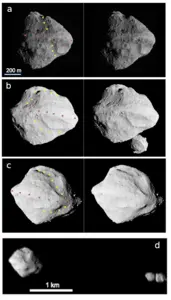To ensure that a satellite orbiting an asteroid was indeed two moons stuck together, the astronomers observing it needed to take a second look. That double take confirmed that they were seeing this phenomenon for the first time, according to a report in Nature.
Last November, NASA’s Lucy — a spacecraft launched to explore asteroids as far away as Jupiter — sailed past its first target, Dinkinesh (which drew the nickname Dinky).
Astronomers following the spacecraft’s data transmission noticed that Dinky had company. A small satellite the team called Selam was orbiting it. As Lucy sent more data back to Earth, the researchers noticed something unusual about the images — the satellite appeared to have two lobes, like halves of a Valentine’s Day heart.
Fusing Two Moons
But they weren’t sure. “In the first images we downloaded of the closest approach, the two lobes were nearly on top of each other,” says Jessica Sunshine, a University of Maryland astronomer, member of the Lucy team, and author of the paper. “When we got a different angle the two lobes were clear.”
The team suspects that the celestial conjoined twin satellite was formed in part, due to Dinky’s high spin speed. Uneven reflection of sunlight on the asteroid’s surface can cause the high speed.
Because of those intense rotations, the asteroid ejected loose debris into orbit, leaving a trough on its surface. However, they are unsure exactly how and why Dinky’s two moons fused to form Selam.
Read More: 12 Science Events to Keep an Eye Out for in 2024
Formation of Celestial Material
Even though both Dinky and Salem are quite small, their importance is massive. They demonstrate how pieces of celestial material come together — or accrete, as astronomers say — to form new bodies.
“Understanding how these very small moons accrete tells us how accretion in general works,” says Sunshine. “Bigger asteroids and ultimately the planets themselves all accrete from smaller asteroids. These are the building blocks of the Solar System.”
Dinkinesh and its satellite are the first of 11 asteroids that Lucy plans to explore over its 12-year journey. Next year, Lucy will cruise past an asteroid belt created by collisions. Data from that pass will improve the understanding of how asteroids break apart.
Lucy will eventually collect data from asteroids even farther out in the Solar System, with its ultimate destination as the Jupiter Trojan asteroids. Then the team will compare the asteroids they’ve observed from different areas.
“Our ultimate goal is to understand the formation of celestial bodies,” Sunshine says. “How do planets form? How was Earth formed?”
Read More: Everything Worth Knowing About … Asteroids
Article Sources
Our writers at Discovermagazine.com use peer-reviewed studies and high-quality sources for our articles, and our editors review for scientific accuracy and editorial standards. Review the sources used below for this article:
Before joining Discover Magazine, Paul Smaglik spent over 20 years as a science journalist, specializing in U.S. life science policy and global scientific career issues. He began his career in newspapers, but switched to scientific magazines. His work has appeared in publications including Science News, Science, Nature, and Scientific American.
Source : Discovermagazine











